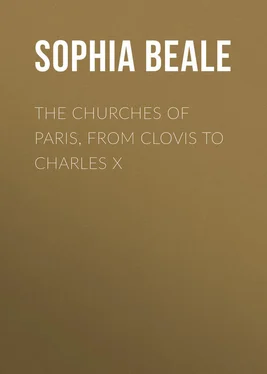Sophia Beale - The Churches of Paris, from Clovis to Charles X
Здесь есть возможность читать онлайн «Sophia Beale - The Churches of Paris, from Clovis to Charles X» — ознакомительный отрывок электронной книги совершенно бесплатно, а после прочтения отрывка купить полную версию. В некоторых случаях можно слушать аудио, скачать через торрент в формате fb2 и присутствует краткое содержание. Жанр: foreign_antique, foreign_prose, на английском языке. Описание произведения, (предисловие) а так же отзывы посетителей доступны на портале библиотеки ЛибКат.
- Название:The Churches of Paris, from Clovis to Charles X
- Автор:
- Жанр:
- Год:неизвестен
- ISBN:нет данных
- Рейтинг книги:3 / 5. Голосов: 1
-
Избранное:Добавить в избранное
- Отзывы:
-
Ваша оценка:
- 60
- 1
- 2
- 3
- 4
- 5
The Churches of Paris, from Clovis to Charles X: краткое содержание, описание и аннотация
Предлагаем к чтению аннотацию, описание, краткое содержание или предисловие (зависит от того, что написал сам автор книги «The Churches of Paris, from Clovis to Charles X»). Если вы не нашли необходимую информацию о книге — напишите в комментариях, мы постараемся отыскать её.
The Churches of Paris, from Clovis to Charles X — читать онлайн ознакомительный отрывок
Ниже представлен текст книги, разбитый по страницам. Система сохранения места последней прочитанной страницы, позволяет с удобством читать онлайн бесплатно книгу «The Churches of Paris, from Clovis to Charles X», без необходимости каждый раз заново искать на чём Вы остановились. Поставьте закладку, и сможете в любой момент перейти на страницу, на которой закончили чтение.
Интервал:
Закладка:
It has always been the custom at the consecration of a church to place a cross wherever the sign of the cross had been made by the bishop. The architect of the Sainte-Chapelle conceived the happy idea of placing the twelve Apostles as pillars of the Church, supporting these crosses, which are in the form of monstrances. The pedestals on which the figures stand are affixed to the pillars, and the statues, like the rest of the church, are painted and gilt, those of the 13th century being marvellous examples of the sculpture of that period. After the closing of the chapel these statues were sent to the Musée des Monuments Français; but when the Museum was suppressed they were dispersed or broken up. S. Peter was discovered in fragments at S. Denis, another was given to the church at Creteil, where it passed as S. Louis, and four were given to the missionaries for their Calvary at Mt. Valerien. The latter were in perfect preservation, and the colour had not disappeared. They remained at the entrance of one of the chapels of the Way of the Cross until 1830, when some senseless vandals threw them down and broke them; but the fragments were preserved, and are now in the garden of the Hôtel Cluny, a museum of fragments. The rest were replaced in the chapel, and are the fourth and fifth on each side facing the altar; all the others are new.
The pavement is modern incised stone, with incrustations of colour, representing geometrical patterns, animals, and flowers. In the apse are subjects – the Four rivers of Paradise , and the Seven Sacraments in the form of rivers. The altar is an exact copy of the original one. Above it is the tribune and canopy where the relics were exposed, with a spiral staircase leading up to it; 8 8 Pour deniers paiés à Jehan de Lille, orfèvre, pour j siège qu'il fist du commandement du Roy pour séoir de lez les saintes reliques en la Saincte Chapelle de Paris-iiij escus. (Comptes royaux.)
the northern one is ancient, and was found by Alexandre Lenoir, in the Musée des Petits-Augustins, where for half a century it had been attached to the façade of the Château de Gaillon, a 16th century work, now in the court of the Ecole des Beaux-Arts. On one side of the apse is a very beautiful piscina . Part of the baldachino is ancient, and the rest has been restored from old drawings.
Formerly several statues occupied places in the chapel; one, a terra-cotta Notre-Dame de Pitié, by Germain Pilon, which is now in the chapel of the military school of St. Cyr. A 16th century jubé , with altars attached to it, marked the nave from the chancel. The retables of these altars (now in the Louvre) were in enamel, signed and dated Léonard Limousin, 1533, and contain portraits of François I. and his second wife, Eléonore d'Autriche, sister of Charles V. and of Henri II. and Catherine de'Medici, all kneeling. The choir was filled with carved stalls of the time of Henri II. At the four corners of the altar pavement, Henri III. elevated bronze Angels upon black marble pillars. On the retro -altar was a silver-gilt model of the chapel, three or four feet high, executed in 1631 by Pijard, goldsmith, and guardian of the relics. This contained some of the treasures, and was considered a very fine work of art, costing some 13,000 livres . There is an excellent drawing of the original altar in Viollet-le-Duc's dictionary. Canon Morand tells us, in his history of the chapel, that the ciborium , which is usually placed in the tabernacle, was here suspended in front of the altar – probably the retro -altar, as in the engraving of the High Altar in the Canon's book, there is no representation of it. All the old furniture of the church has disappeared, the carved stalls, the jubé , the altars, and the pulpit. Upon the subject of letting, or taking money for seats or chairs in church, the Abbé waxes wrathful. Nothing is more "indécent que de vendre ou de louer des places à l'Eglise. En Angleterre et en Hollande on est assis dans les Temples sans aucun frais, et sans être interrompu par les Mandians, par les quêteurs, ou par les loueurs de chaises; en quoi les non-Catholiques nous donnent un bel exemple à suivre, si nous étions assez raisonables et assez désinterressés pour cela." This is a proof that the letting of pews which prevailed in this country some years ago was a bad departure from the free-and-open seat system of the last century; and the picture drawn of the restlessness of a French church, from the incessant perambulating of the Suisses , the quêteurs , and the chair-owners, is as true now as it was in the time of Morand.
The Canon then goes on to record the want of reverence of the congregation, how they just half kneel when the bell rings; how they must needs sit, and even gossip, during the short quarter of an hour occupied by a low mass; how they take snuff and bear themselves generally, and then go out and stand about for the greater part of the day at their business.
S. Louis ordained, in his foundation charters, that the offerings received by the priests at the altar should be devoted to the reparation of the glass, and that if it should be insufficient, the necessary funds should be taken from the Royal Treasury deposited at the Temple. The restoration of the windows is now complete, this being the work of MM. Steinheil and Lusson. These artists have done their work so well, and matched the colours so perfectly, that it is difficult to distinguish the new from the old. The rose-window is of the 15th century, the others of the 13th century. The subjects are from the Old and New Testament, and from the life of S. Louis. Some of these latter are original, and, as it is probable that the artists assisted at the ceremonies held in the chapel, it is also probable that the pictures may be true portraits of the personages represented. The subjects of the rose-window are all taken from the Apocalypse.
Such is the chapel which was so dear to the King that he felt a " malaise " when he heard divine service elsewhere, and of which the troubadour Rutebeuf sings the praises in a poem written after the death of the Saint, entitled, Les Regrès au roys Loeys :
Chapèle de Paris! bien ères maintenue
La mort, ce m'est aduis, t'a fet desconvenue
Du miex de tes amys, t'a laissée toute nue
De la mort, sont plaintifs et grant gent et menue." —
SAINT-DENIS
Although the Benedictine abbey church of S. Denis is some miles from Paris, it is so mixed up with the history of the capital that it ought not to be omitted in a series of "Paris Churches." Moreover, as it is by far the finest church in, or near, the metropolis, and one of the grandest examples of French 13th century architecture, no one ought to grudge the tiresome journey by train or tram in order to see it, even if his stay in Paris be limited to a few days. The only thing required to make it perfectly beautiful is new stained glass in the windows of the clerestory to replace that put up during the early years of this century, a horrible example of the execrable taste of the period.
S. Denis was one of the sacred spots of mediæval Europe – a species of Christian Mecca. "Si les lieux sont reputez saincts," says one of its children, Dom Millet, 9 9 Religious, Benedictine of the convent (congregation) of S. Maur, Order of S. Benedict.
"à cause des choses sainctes faictes ou aduenuës en iceux, comme ont esté est sont encores, les montagnes de Thabor et de Caluaire, ou bien à cause des choses sainctes qu'ils contiennent, comme estoit l'Arche d'Alliance, et le Sancta Sanctorum des Juifs; je croy qu'il n'y a personne qui n'aduoüe que l'Eglise de S. Denys en France ne soit vn lieu tres-sainct en toutes ces considerations, puis qu'elle a esté dediée des propres mains de nostre Sauueur Jesus-Christ, descendu exprés du Ciel auec vne grande multitude d'Anges et de Saincts, et qu'elle contient en soy tant des choses sainctes, et des Reliques si precieuses et rares." It was a poor but worthy leper who saw this strange vision. He had been left shut up in the church, when in the dead of night he was startled by a dazzling light; and then he beheld the Saviour, His Apostles, multitudes of Angels, and S. Denis and his companions. Our Lord sprinkled the church with holy water, and S. Denis and his companions served Him; and then He said to the leper: " Go and tell le bon roy Dagobort what thou hast seen. " " But how can a poor leper penetrate the presence of the King? " said he. Then a wondrous miracle was performed; the Saviour touching him with his finger, made the leper clean. Then he went to the King, and they all believed.
Интервал:
Закладка:
Похожие книги на «The Churches of Paris, from Clovis to Charles X»
Представляем Вашему вниманию похожие книги на «The Churches of Paris, from Clovis to Charles X» списком для выбора. Мы отобрали схожую по названию и смыслу литературу в надежде предоставить читателям больше вариантов отыскать новые, интересные, ещё непрочитанные произведения.
Обсуждение, отзывы о книге «The Churches of Paris, from Clovis to Charles X» и просто собственные мнения читателей. Оставьте ваши комментарии, напишите, что Вы думаете о произведении, его смысле или главных героях. Укажите что конкретно понравилось, а что нет, и почему Вы так считаете.




![Theresa Cheung - The Dream Dictionary from A to Z [Revised edition] - The Ultimate A–Z to Interpret the Secrets of Your Dreams](/books/692092/theresa-cheung-the-dream-dictionary-from-a-to-z-r-thumb.webp)







